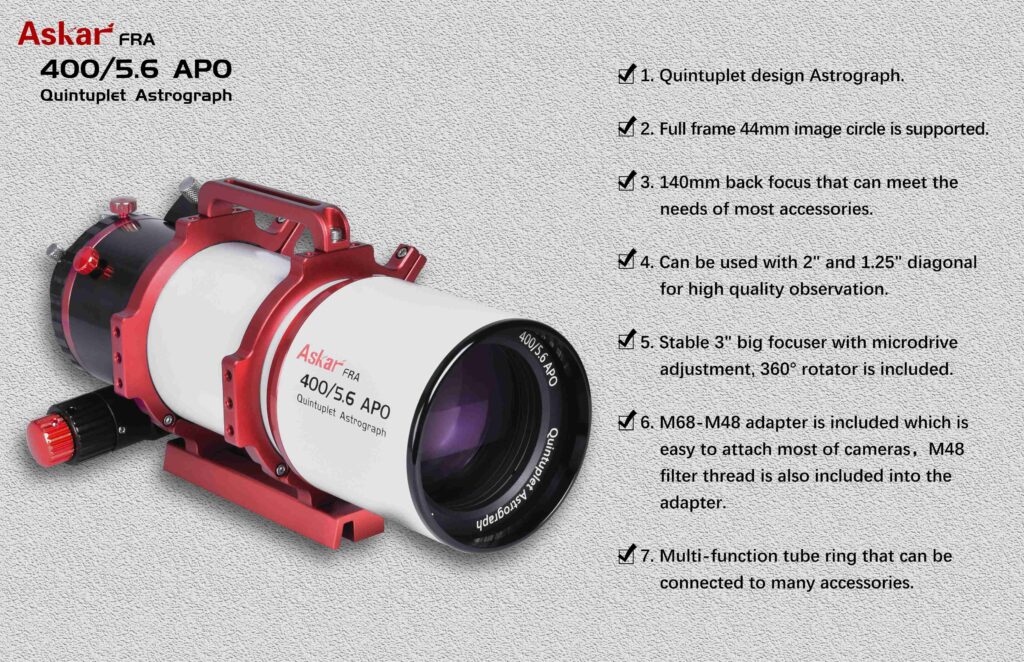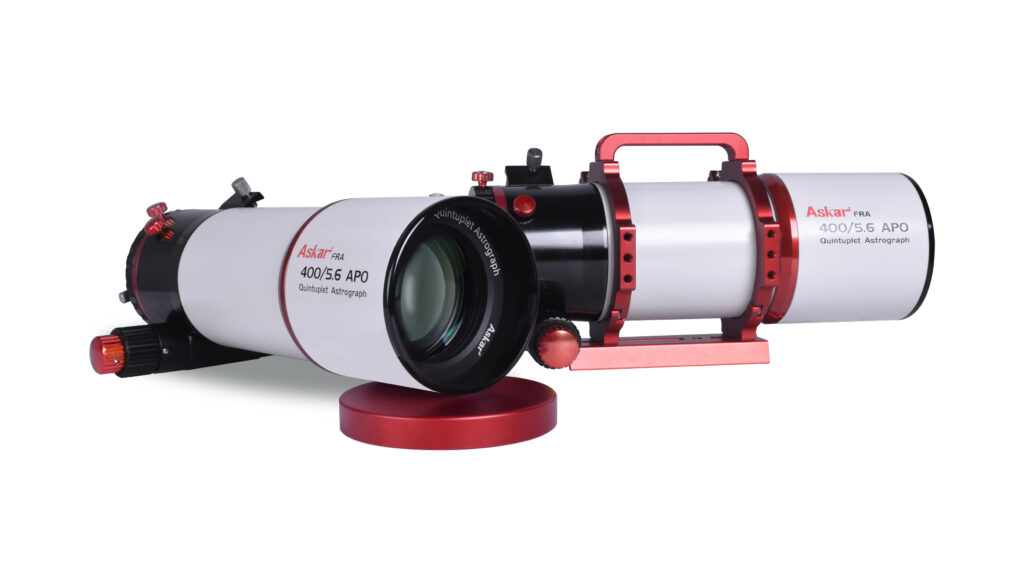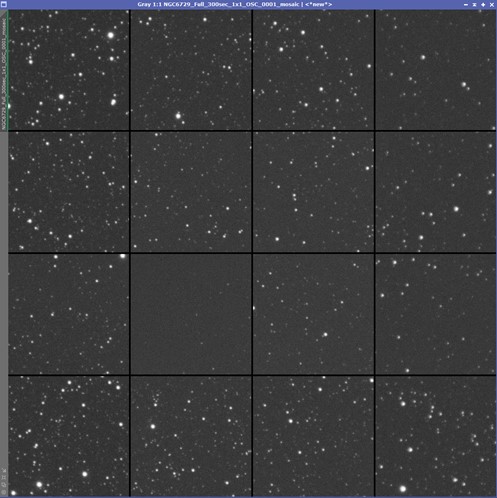Review: Askar FRA400 Quintuplet Refractor

Introduction
The past few years have seen a significant shift in the markets for astronomy gear and one you may have not really noticed as its been very subtle in its occurrence.
If like me you’re a serial online astro shopper (well more serial browser as I don’t own 20 scopes!) then you will have noticed a slow but steady penetration of the markets by Chinese manufacturers directly releasing telescopes under their own brand names versus creating equipment for resale under more well-known big name brands.
This slow but steady movement in direct marketing and selling has come from improvements in both technical and manufacturing capabilities but also the realisation that these quality optics can compete directly with the big name brands on the world markets and especially when supported by online direct markets and usually with some very attractive prices versus normal resellers.
Still, many astro photographers are very wary of buying from overseas companies, but is that reasonable?
If you look at any of the major dealers you will find cameras, filters, telescopes and practically every kind of accessory, all from Chinese manufacturers. That’s not surprising given that much of the equipment we buy, even from very well-known brands, has probably originated in China, but with a more open market economy you can also buy directly from dealers in China or via more recognised means such as AliExpress.
Of course, these manufacturers have been quick to build trusted relationships with many of the dealers who have recognised the potential of these suppliers and you can still buy from your normal local dealer too, although maybe not with the same lower prices directly but you do get the reassurance of a local dealer.

Sharpstar Optics and the launch of Askar
One supplier that many will recognise is sold under the brand Sharpstar, who have become a well-known provider of quality telescopes for astro photographers.
Sharpstar is a brand name of the Jiaxing Ruixing Optical Instrument Company located in Jiaxing city in China’s Zhejiang province. A number of western dealers sell Sharpstar telescopes and they build some fine instruments that can compete with many of the bigger names, but they also supply a range of mid-priced telescopes that are still excellent performers but at a price point that makes them very attractive and puts quality telescope optics in the hands of someone who may not have the means to purchase high end high telescopes but still desires to own something that performs well.
Following the success of Sharpstar, Jiaxing Ruixing Optical recently launched a new brand, Askar, to market some of its newer products to the astronomy market. Askar have released some interesting products including the ACL200 f4 astrophotography lens for DSLRs, the tiny and rather unique, FMA180 wide field astrograph lens and, the subject of this review, the FRA400 Quintuplet Astrograph refractor.
Sharpstar and Askar are continuing to develop some interesting products and I will be having a closer look at some of these other products in future so watch out for further reviews. And for openness, the items in this review were purchased by myself for my own use and I have not been sponsored by Askar/Sharpstar for this article.

The FRA400 Astrograph Refractor
FRA stands for Flatfield Refractive Astrograph and this beautiful wide field scope fits well to that acronym. The FRA400 is a short 72mm aperture refractor with a native focal length of 400mm at f5.6 but has the option for a 0.7 focal reducer to widen the field and improve speed to a speedy f3.9.
This little telescope is built on a Petzval design and has a three-element main objective with two main ED elements with non ED centre, an inbuilt 2 element field flattener, which uses an additional ED element for a true flat field experience and produces a 44mm image circle, perfect use with full frame cameras.
The FRA400 comes fitted with a large 3” focuser and includes the standard 10:1 micro focuser, a 68mm-48mm adapter on the rear and a 1.25” eyepiece adapter is also included in the base kit.
A Vixen style dovetail is fitted as standard as well as a set of rather interesting red anodised scope rings that include mounting points on three side. These mounting points are an interesting development and the top side of these includes a small carry handle as standard.
A short red trimmed dew shield finishes off the OTA and while this uses a friction fit, it did not slip in use.
Askar also sell additional mounting plates so you can attach other accessories to the FRA400 and you can even remove the carry handle and add an additional plate in this location for more space.
This would make a superb scope for mounting an ASIAIR to, making for a very lightweight setup suitable for a lightweight mount or even a camera tracker.
The main Optical Tube Assembly is finished in a nice white finish. The focuser is black, trimmed with red highlights and the dew shield also finished with a red metal trim. The vixen style dovetail and rings are finished in a red anodised coating and a matching red anodised metal lens cap finishes the overall look. All fixtures are nicely finished and look and feel like a quality item.
Overall, the finish looks beautiful and the paint and anodising nicely done, it looks very well made and parts finished beautifully. This really does feel like a quality instrument.
The telescope comes in an attractive box and I think is one of the first telescopes I have seen with a colour printed box. I cannot recall any other scope I purchased coming so well packaged either, which is a credit to Askar.
I also received the matching focal reducer which is also presented in a nice printed sturdy box.
Both scope and reducer come with instruction manuals which is good if this might be a first scope for you and the instruction booklet details various setups and diagrams to help guide you.
What’s In the Box
Opening the shipping box reveals a good amount of packaging and protection and the scope was received double boxed in a strong brown cardboard outer as well.
The telescope box also contains an extension tube, also fitted with filter threads, a small bag of spare screws and there is even a hex key included in the kit to fit the machine screws on the scope rings.
I was extremely interested in the focal reducer as this really increases the capability of this little scope. It increases the field of view but also creates a fast astrograph reducing exposure times.
Opening the printed box reveals a well packaged reducer which is a multi-element design with a huge aperture capable of supporting full frame cameras.
packaged reducer which is a multi-element design with a huge aperture capable of supporting full frame cameras.
The reducer also comes with a set of instructions and includes metal end caps. I was really pleased to see the reducer is also fitted with internal threads for 48mm filters, something I find missing on many reducers and correctors on the market.
The x0.7 reducer is a thing of beauty and quite weighty, it’s a beautiful bit of engineering. Askar have really thought out the design and kindly added internal threads to parts to allow easy fitting of filters which meant I could quickly add my UVIR cut filter or my L-Enhance filters to either the extension tube or focal reducer very easily.
The scope weighs about 2.4kg with no reducer and about 2.8kg with the reducer fitted and its worth noting that the reducer fits inside the focuser drawer tube which reduces the overall length. Again, a nice thought when building a compact wide field scope. It’s simple to fit, you simply remove the rear adapter and screw the reducer into the rotator.
When not using the reducer, it can be replaced with the small extension tube supplied with the main telescope package. The standard focal length is a nice 400mm at f5.6 With the reducer the focal length is reduced to 280mm and turns the scope into a very speedy f3.9 astrograph, which really gathers light quickly as you will see from my sample images.
images.
The reducer has a standard back focus length of 55mm, and I was keen to see how well this performed as using a reducer at such fast speeds can be quite demanding on tolerances to keep stars round across the field and many ‘55mm back focus’ reducers need to be tuned to get decent shaped stars.
I must mention the camera rotator as well, as its probably the nicest stock one I have come across on scopes I have used.
The rotator feels exceptionally smooth with no lateral play when the locking screw is tightened and has no slop in it at all – its feels very solid. I think I might print off some markings as it has no scales on the outside to help with managing my rotation angles, but I can get it pretty close by eye and experience using my William Optics manual ones.
A camera rotator is one of the most useful items when doing mosaics or set field of views in Sequence Generator Pro for example. Once you have used one you will wonder how you managed without!
Prepping for First Light
I run autofocus with all my telescopes and I decided I was going to fit a ZWO EAF to this rig so that I can test the ASIAIR and my Primalucelabs Eagle with it mounted to my Ioptron CEM40 for some long overnight unattended runs.
I was pleased to find that some thought has gone into the focuser design too. If you want to run a small lightweight rig specifically for the ASIAIR then this is the scope for you as its already to accept one right out of the box.

The 3” focuser is well made and has all the holes needed to directly install the EAF with the screws in the EAF kit and I think this scope qualifies for the fastest install of an EAF!
It literally took 5 minutes to install and setup the EAF thanks to the clever idea of including the threaded holes in the focuser body for an EAF.
Nothing to remove – just bolt it on. Of course, it comes in a matching red finish!
For my first tests I decided to run the FRA400 in wide field mode using the reducer and my trusty ZWO ASI2600MC Pro One-Shot Colour camera with its 26mpx APS-C sensor. I was extremely interested to see how well the stars appeared in this wide field setup and how it would perform at f3.9.
I installed my standard Astronomiks L2 UVIR cut directly onto the threads inside the body of the reducer. An easy install – nice!
My first tests were run using the Primaluce Eagle 3 computer mounted onto top of a mounted vixen rail which is my normal operating mode.
Setting up this rig in Sequence Generator Pro was simple and I used my common short refractor settings for the EAF to quickly set up a profile for the FRA400. Of course, it was raining when I received the FRA400, so I set about testing and doing some flats in preparation for some clear skies.
The first thing I liked about this scope was my flats were free of vignetting and this was confirmed during my first night-time test shots. In fact, I integrated my first initial tests with no flats, and they came out very well showing no noticeable dark areas in the corners. So my initial images showed a nice flat field with well-shaped stars even at the edge – all good so far.
First Light

My first test was a 2-panel mosaic of Rho Ophuchi, a personal favourite of mine and one I was keen to see an image on before the poor weather kicked in again.
I had a full clear night just a day after I received the scope, highly unusual! So, I decided to run 4 hours on each panel to see how much data this would collect in just one evening using such a fast, wide field setup using the Eagle and ASI2600.
As Antares wasn’t high enough just after dark, I took some test shots with both the reducer and also at full focal length to check on field flatness and star shapes and was pleased to see little evidence in the corner of off round stars with or without the reducer in use.
There was with no tweaking of the back focus necessary using the reducer and I doubt I will bother trying to tune it any further given how well it looked.
There was perhaps evidence of some tilt in one corner but only if I was being super critical and only when zoomed in and that might well be showing a little sensor tilt in the ASI2600 at this fast speed but otherwise the field was pretty flat for an attractively priced telescope at this price range.
I collected about 40 images per panel and these went into my normal Pixinsight processing run and I was very pleased with the outcome.
Stitching the mosaic was easy as there were no poor corners to deal with, which is a big benefit. Illumination was very equal across the frame and while under sampled at 2.75 arcsec/px, the drizzle process reduces this and provides a lovely, well sampled, final image with good star shape.

I was very pleased with the image given such a short window – I will definitely revisit this later in the winter should we get a couple nights window and I will try a wider mosaic but this was pretty pleasing from one session.
As always in New Zealand the weather has been unkind this winter and limited my test shots prior to this article.
I was also able to get a short 3 hour run on NGC6729 at full focal length and the results are again quite pleasing.
At the full 400mm the stars look good edge to edge and the field illumination good.
To show how good the image of NGC6729 here was processed only with darks.
I think you will agree the results are pretty impressive using the APS-C sensor of the ASI2600.
This is also a drizzled image to manage the under sampled pixel scale.
I am still impressed with the results given the short window I had available. I would see no further tuning required on spacing or alignment of focuser tilt.


Conclusion
The FRA400 is a wonderful compact scope that provides a good flat field suitable for cameras up to full frame and at a very reasonable price. If you are looking for a true wide field scope to compete with the focal length of a Redcat for example, then this may well be the scope for you, especially if you want something easy to fit out for autofocus.
The ability to fit a ZWO EAF to the focuser out of the box within a few minutes was a fantastic experience and when combined with an ASIAIR this will make a very capable lightweight, wide field rig with the reducer and at f/3.9 a real light gathering machine. Even at full 400mm and f/5.6 the scope is a superb performer and a pleasure to use.
Askar should be commended for the inclusion of well thought out features like a quality camera rotator as standard, the new style rings and dovetail, the inclusion of threads for filters in the reducer and extension tubes and the quality packaging and instructions. The focal reducer is really well built, and I loved the mounting method inside the drawer tube/rotator body.
There’s a lot to like about this little scope and I look forward to doing some narrowband images using it with my ASI1600GT and Chroma filters. I am sure it will become a popular scope and I’d highly recommend the FRA400’s build and finish if your looking for a small widefield scope.
New FRA Series Telescopes
Since this article was first written ASKAR/Sharpstar have added two new telescopes to the FRA range. The FRA600 with a 108mm aperture, 600mm focal length at f/5.6 and the FRA500 with a 90mm aperture and 500mm focal length at f/5.6
Further Information
Further details on the FRA range http://www.askarlens.com/
